
April is Oral Cancer Awareness Month and Head and Neck Cancer Awareness Month.
According to the American Dental Association, oral cancer includes the lips, gums, roof and floor of the mouth, inner cheeks as well as the tongue. Head and neck cancer occurs at the base of the tongue, the tonsils and throat.
Early detection of these cancers helps with treatment and survival. According to the Oral Cancer Foundation, over 58,000 people will be diagnosed this year with males twice as commonly affected as females.

Use of tobacco products (including cigarettes, cigars, pipe smoking, chew, snuff and betel quid) and alcohol are some of the biggest risk factors for oral cancers. However, a growing number of younger individuals are being diagnosed with head and neck cancer due to an infection with Human papillomavirus (HPV). Up to 70% of cancers found in the oropharynx (base of the throat and tonsils) are associated with HPV, according to the American Cancer Society.

What are the signs of oral cancer?
- Non-healing lesions or sores on any part of the tongue, throat or gums
- Red or white patches in any part of the mouth that last longer than two weeks
- Lumps or bumps in the neck
- Difficulty chewing, swallowing or moving the jaw/tongue
- Sore throat or a feeling of something “stuck” in the throat
- Hoarseness of the voice
- Swelling of the jaw (causes dentures to fit poorly or become uncomfortable)
- A lump or thickening of oral soft tissues
- Ear pain
- Numbness of the tongue or other areas of the mouth
Find instructions to self-screen and check for warning signs on your own from the American Association of Oral and Maxillofacial Surgeons.
If you experience any of these symptoms, be sure to seek out care from your medical or dental provider.

What can you do to lower your risk?
- Maintain regular dental visits. Part of your routine dental visit is a comprehensive oral exam.
- Avoid tobacco, even secondhand smoke exposure. If you smoke cigarettes, try to quit or cut back. Avoid chewing tobacco.
- Wear SPF-containing lip balm.
- Limit alcohol use.
- Talk with your doctor about getting the HPV vaccine if you are eligible. The HPV vaccine works best before exposure to any of the HPV virus types. Vaccine eligibility depends on age.
- Eat a healthy diet including lots of fruits and vegetables.
- Maintain a healthy weight.
- Find ways to stay active every day.
Your dental provider screens you for oral cancer at your routine visits. This is another reason to keep up on your preventive check-ups!
Sources:
This information in this post is for general educational purposes only and does not warrant or represent any information as related to health as specifically appropriate for you. It is not intended to be medical advice or replace the relationship that you have with your health care providers. You should always seek medical advice on any diagnosis or treatment from a qualified health care provider. The information is provided “as is” without any representations or warranties, express or implied.





